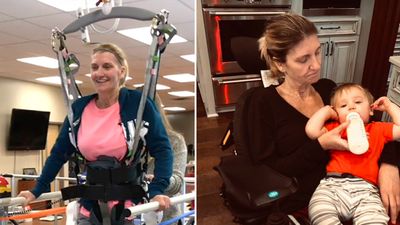Move Over, Iron Man. A Real-Life Power Suit Helped This Paralyzed Grandmother Learn to Run.
Puschel Sorensen first noticed something was wrong when her fingertips began to tingle. Later that day, she grew weak and fell.
It picked up small electrical impulses on her skin's surface and turned them into full movement in her legs.
Her family rushed her to the doctor, where she received the devastating diagnosis of Guillain-Barré Syndrome -- a rare and rapidly progressing autoimmune disorder that attacks the myelin sheath covering nerves.
Sorensen, a once-spry grandmother in her late fifties, spent 54 days in intensive care in 2018. When she was finally transferred to a rehab facility near her home in Florida, she was still on a feeding tube and ventilator, and was paralyzed from the neck down. Progress with traditional physical therapy was slow.
(Photo Credit: Brooks Rehabilitation Hospital)
Sorensen in the hospital after her diagnosis of Guillain-Barré syndrome.
And then everything changed. Sorensen began using a cutting-edge technology called an exoskeleton to relearn how to walk. In the vein of Iron Man's fictional power suit, it confers strength and mobility to the wearer that isn't possible otherwise. In Sorensen's case, her device, called HAL – for hybrid assistive limb -- picked up small electrical impulses on her skin's surface and turned them into full movement in her legs while she attempted to walk on a treadmill.
"It was very difficult, but super awesome," recalls Sorensen, of first using the device. "The robot was having to do all the work for me."
Amazingly, within a year, she was running. She's one of 38 patients who have used HAL to recover from accidents or medical catastrophes.
"How do you thank someone for giving them back the ability to walk, the ability to live your life again?" Sorensen asks effusively.
It's still early days for such exoskeleton devices, which number perhaps a few thousand worldwide, according to data from the handful of manufacturers who create them with any scale. But the devices' ability to dramatically rehabilitate patients like Sorensen highlights their potential to extract untold numbers of people from wheelchairs, and even to usher in a new paradigm for caregiving – one of the fastest growing segments of the U.S. economy.
"I've been a physical therapist for 16 years, and (these devices) help teach patients the right way to move in rehabilitation," says Robert McIver, director of clinical technology at the Brooks Cybernic Treatment Center, part of the Brooks Rehabilitation Hospital in Jacksonville, Fla, where Sorensen recovered.
Another patient there, a 17-year-old named George with a snowboarding injury that paralyzed his legs, was getting around with a walker within 20 sessions.
As patients progress in their recoveries, so does exoskeleton technology. Jack Peurach, CEO of Ekso, one of the leaders in the space, believes within a decade they could resemble an article of clothing (a "magic pair of pants" is his phrase). They also may become inexpensive and reliable enough to transition from a medical to a consumer device. McIver sees them eventually being used in the home on an ongoing basis as a personal assistive device, much like a walker or cane, to prevent falls in elderly people.
Such a transition "certainly could eventually lessen the need for caregivers," says Sharona Hoffman, a professor of law at Case Western University in Cleveland who has written extensively on aging and bioethics. "We have a real shortage of caregivers, so that would be a good thing."
Of course, having an aging and disabled population using exoskeletons in much the same way as an Apple Watch raises issues of its own.
Dr. Elizabeth Landsverk, a California-based geriatrician and founder of a company that performs house calls for elderly patients, believes the tech holds some promise in easing the burden on caregivers, who sometimes have to lift or move patients without assistance. But she also believes exoskeletons could become overhyped.
"I don't see robotics as completely replacing the caregiver," she says. And even if exoskeletons became akin to articles of clothing, she is skeptical of how convenient they could become.
"It's hard enough to get into support hose. Would an older person be able to get in and out of it on their own?" she asks, noting that a patient's cognitive levels could pose a huge barrier to donning such a device without assistance.
If personal exoskeletons did wildly succeed, Hoffman wonders whether they would leave the elderly more physically mobile yet also more socially isolated, since caregivers or even residing in an assisted living facility may no longer be required. Or, if they were priced in the hundreds or thousands of dollars, he worries that the cost would exacerbate social inequalities among the elderly and disabled.
"It's almost like a bad dream that [my illness] happened."
With any technology that confers superhuman ability, there's also the question of appropriate usage. Even the fictional Power Loader in the movie Alien required an operator's license. In the real world, such an approach would likely pay dividends.
"We would have to make sure physicians are well-trained in these devices, and patients have a way of getting training to operate them that is thorough and responsible," Hoffman says.
But despite some unresolved questions, it is a remarkable achievement to be able to give people back their lives thanks to new technology.
"It's almost like a bad dream that [my illness] happened," says Sorensen, who managed to walk in her daughter's wedding after her recovery. "Because now everything is pretty much back to normal and it's awesome."
Puschel Sorensen undergoing physical therapy using Cyberdyne's hybrid assistive limb, left, and with her grandson while still in a wheelchair.
